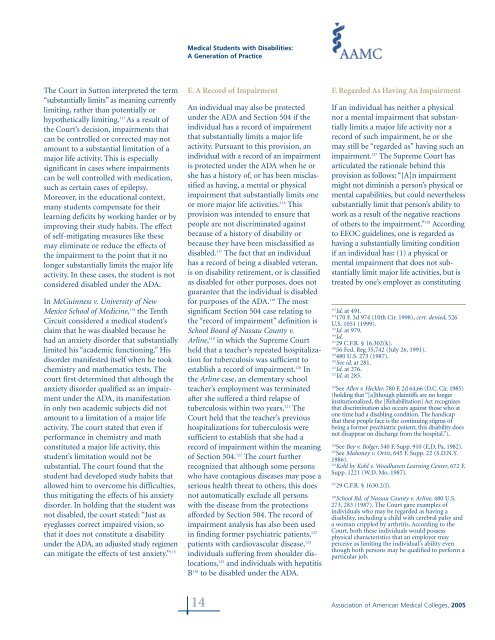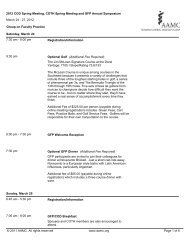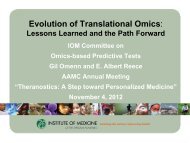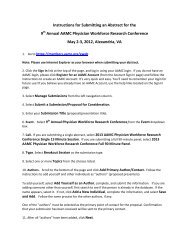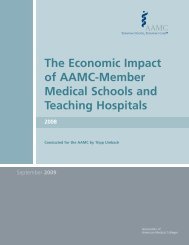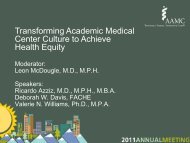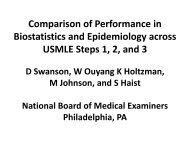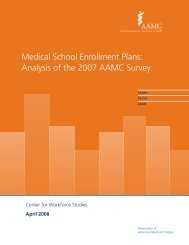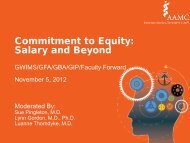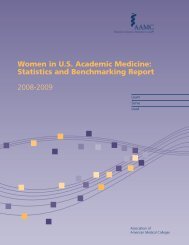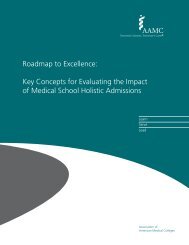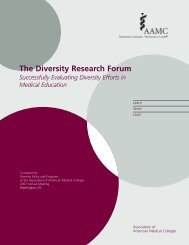Medical Students with Disabilities: A Generation of Practice
Medical Students with Disabilities: A Generation of Practice
Medical Students with Disabilities: A Generation of Practice
You also want an ePaper? Increase the reach of your titles
YUMPU automatically turns print PDFs into web optimized ePapers that Google loves.
<strong>Medical</strong> <strong>Students</strong> <strong>with</strong> <strong>Disabilities</strong>:<br />
A <strong>Generation</strong> <strong>of</strong> <strong>Practice</strong><br />
The Court in Sutton interpreted the term<br />
“substantially limits” as meaning currently<br />
limiting, rather than potentially or<br />
hypothetically limiting. 113 As a result <strong>of</strong><br />
the Court’s decision, impairments that<br />
can be controlled or corrected may not<br />
amount to a substantial limitation <strong>of</strong> a<br />
major life activity. This is especially<br />
significant in cases where impairments<br />
can be well controlled <strong>with</strong> medication,<br />
such as certain cases <strong>of</strong> epilepsy.<br />
Moreover, in the educational context,<br />
many students compensate for their<br />
learning deficits by working harder or by<br />
improving their study habits. The effect<br />
<strong>of</strong> self-mitigating measures like these<br />
may eliminate or reduce the effects <strong>of</strong><br />
the impairment to the point that it no<br />
longer substantially limits the major life<br />
activity. In these cases, the student is not<br />
considered disabled under the ADA.<br />
In McGuinness v. University <strong>of</strong> New<br />
Mexico School <strong>of</strong> Medicine, 114 the Tenth<br />
Circuit considered a medical student’s<br />
claim that he was disabled because he<br />
had an anxiety disorder that substantially<br />
limited his “academic functioning.” His<br />
disorder manifested itself when he took<br />
chemistry and mathematics tests. The<br />
court first determined that although the<br />
anxiety disorder qualified as an impairment<br />
under the ADA, its manifestation<br />
in only two academic subjects did not<br />
amount to a limitation <strong>of</strong> a major life<br />
activity. The court stated that even if<br />
performance in chemistry and math<br />
constituted a major life activity, this<br />
student’s limitation would not be<br />
substantial. The court found that the<br />
student had developed study habits that<br />
allowed him to overcome his difficulties,<br />
thus mitigating the effects <strong>of</strong> his anxiety<br />
disorder. In holding that the student was<br />
not disabled, the court stated: “Just as<br />
eyeglasses correct impaired vision, so<br />
that it does not constitute a disability<br />
under the ADA, an adjusted study regimen<br />
can mitigate the effects <strong>of</strong> test anxiety.” 115<br />
E. A Record <strong>of</strong> Impairment<br />
An individual may also be protected<br />
under the ADA and Section 504 if the<br />
individual has a record <strong>of</strong> impairment<br />
that substantially limits a major life<br />
activity. Pursuant to this provision, an<br />
individual <strong>with</strong> a record <strong>of</strong> an impairment<br />
is protected under the ADA when he or<br />
she has a history <strong>of</strong>, or has been misclassified<br />
as having, a mental or physical<br />
impairment that substantially limits one<br />
or more major life activities. 116 This<br />
provision was intended to ensure that<br />
people are not discriminated against<br />
because <strong>of</strong> a history <strong>of</strong> disability or<br />
because they have been misclassified as<br />
disabled. 117 The fact that an individual<br />
has a record <strong>of</strong> being a disabled veteran,<br />
is on disability retirement, or is classified<br />
as disabled for other purposes, does not<br />
guarantee that the individual is disabled<br />
for purposes <strong>of</strong> the ADA. 118 The most<br />
significant Section 504 case relating to<br />
the “record <strong>of</strong> impairment” definition is<br />
School Board <strong>of</strong> Nassau County v.<br />
Arline, 119 in which the Supreme Court<br />
held that a teacher’s repeated hospitalization<br />
for tuberculosis was sufficient to<br />
establish a record <strong>of</strong> impairment. 120 In<br />
the Arline case, an elementary school<br />
teacher’s employment was terminated<br />
after she suffered a third relapse <strong>of</strong><br />
tuberculosis <strong>with</strong>in two years. 121 The<br />
Court held that the teacher’s previous<br />
hospitalizations for tuberculosis were<br />
sufficient to establish that she had a<br />
record <strong>of</strong> impairment <strong>with</strong>in the meaning<br />
<strong>of</strong> Section 504. 122 The court further<br />
recognized that although some persons<br />
who have contagious diseases may pose a<br />
serious health threat to others, this does<br />
not automatically exclude all persons<br />
<strong>with</strong> the disease from the protections<br />
afforded by Section 504. The record <strong>of</strong><br />
impairment analysis has also been used<br />
in finding former psychiatric patients, 123<br />
patients <strong>with</strong> cardiovascular disease, 124<br />
individuals suffering from shoulder dislocations,<br />
125 and individuals <strong>with</strong> hepatitis<br />
B 126 to be disabled under the ADA.<br />
F. Regarded As Having An Impairment<br />
If an individual has neither a physical<br />
nor a mental impairment that substantially<br />
limits a major life activity nor a<br />
record <strong>of</strong> such impairment, he or she<br />
may still be “regarded as” having such an<br />
impairment. 127 The Supreme Court has<br />
articulated the rationale behind this<br />
provision as follows: “[A]n impairment<br />
might not diminish a person’s physical or<br />
mental capabilities, but could nevertheless<br />
substantially limit that person’s ability to<br />
work as a result <strong>of</strong> the negative reactions<br />
<strong>of</strong> others to the impairment.” 128 According<br />
to EEOC guidelines, one is regarded as<br />
having a substantially limiting condition<br />
if an individual has: (1) a physical or<br />
mental impairment that does not substantially<br />
limit major life activities, but is<br />
treated by one’s employer as constituting<br />
113<br />
Id. at 491.<br />
114<br />
170 F. 3d 974 (10th Cir. 1998), cert. denied, 526<br />
U.S. 1051 (1999).<br />
115<br />
Id. at 979.<br />
116<br />
Id.<br />
117<br />
29 C.F.R. § 16.302(k).<br />
118<br />
56 Fed. Reg 35,742 (July 26, 1991).<br />
119<br />
480 U.S. 273 (1987).<br />
120<br />
See id. at 281.<br />
121<br />
Id. at 276.<br />
122<br />
Id. at 285.<br />
123<br />
See Allen v. Heckler, 780 F. 2d 64,66 (D.C. Cir. 1985)<br />
(holding that “[a]lthough plaintiffs are no longer<br />
institutionalized, the [Rehabilitation] Act recognizes<br />
that discrimination also occurs against those who at<br />
one time had a disabling condition. The handicap<br />
that these people face is the continuing stigma <strong>of</strong><br />
being a former psychiatric patient; this disability does<br />
not disappear on discharge from the hospital.”).<br />
124<br />
See Bey v. Bolger, 540 F. Supp. 910 (E.D. Pa. 1982).<br />
125<br />
See Mahoney v. Ortiz, 645 F. Supp. 22 (S.D.N.Y.<br />
1986).<br />
126<br />
Kohl by Kohl v. Woodhaven Learning Center, 672 F.<br />
Supp. 1221 (W.D. Mo. 1987).<br />
127<br />
29 C.F.R. § 1630.2(l).<br />
128<br />
School Bd. <strong>of</strong> Nassau County v. Arline, 480 U.S.<br />
273, 283 (1987). The Court gave examples <strong>of</strong><br />
individuals who may be regarded as having a<br />
disability, including a child <strong>with</strong> cerebral palsy and<br />
a woman crippled by arthritis. According to the<br />
Court, both these individuals would possess<br />
physical characteristics that an employer may<br />
perceive as limiting the individual’s ability even<br />
though both persons may be qualified to perform a<br />
particular job.<br />
14 Association <strong>of</strong> American <strong>Medical</strong> Colleges, 2005


